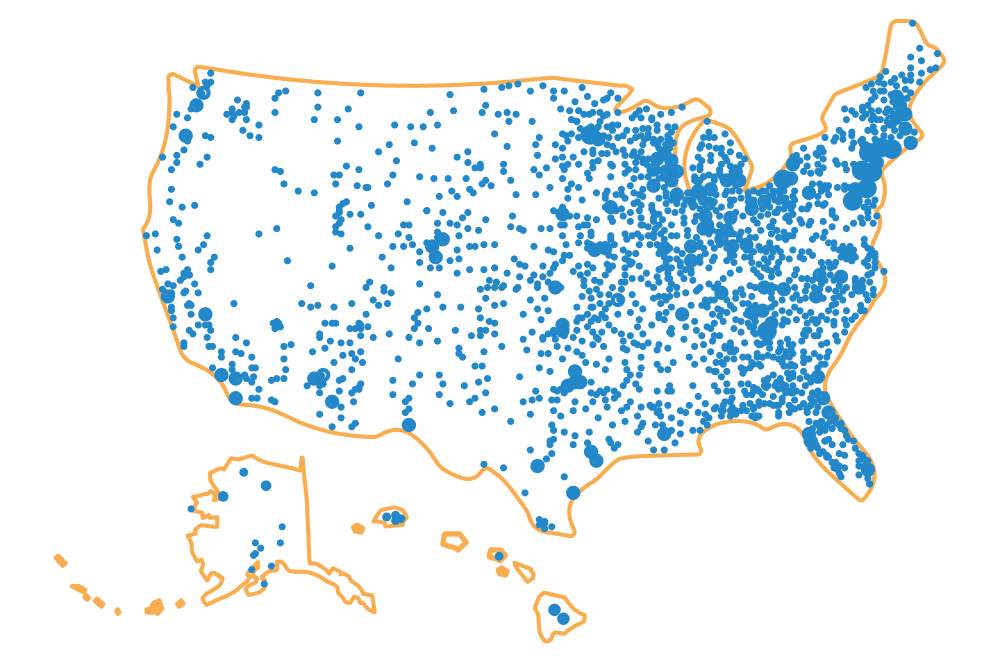As the adage goes, “Knowledge is power.” As you research the best ways to save for your children’s child’s education after high school, you’ll discover that Ohio 529 CollegeAdvantage is one of your best options. There are many great reasons to choose to save in Ohio’s 529 Plan; we’ve chosen 10 benefits to highlight.
1) Ohio 529 tax advantages
Since 1989, Ohio 529 has helped families across the nation save money for their children’s future education with tax-advantaged benefits. First, all contributions and earnings grow tax free in a 529 college savings plan, so all investment growth is yours. Second, a 529 withdrawal is tax free when used to pay qualified higher education expenses. Third, Ohio residents who contribute to an Ohio 529 account can deduct those donations from their Ohio taxable income. The deduction is $4,000 per year, per beneficiary, with unlimited carry forward, which means an Ohio resident can subtract $4,000 per year from their Ohio taxable income until all contributions are deducted.
2) Use Ohio 529 for whatever school comes after high school
529 plans aren’t just for traditional four-year colleges or universities. Maybe your child is interested in starting at a community college or earning an associate degree? Maybe they want to receive career training to learn important skills at a trade or vocational program? Or do they show great aptitude in a certain field and want to pursue an apprenticeship in it? You can use your 529 account at any federally accredited educational institution – whether for an associate, bachelor’s, professional, or vocational degree. In fact, your child can also use a 529 plan to cover qualified expenses for graduate school.
Certain apprenticeships costs — such as fees, textbooks, supplies, and equipment, including required trade tools— can be paid with a 529 withdrawal. The apprenticeship program must be registered with the Secretary of Labor’s National Apprenticeships Act to use a tax-free withdrawal from a 529 plan.
If your child wants to attend a military academy after high school, they won’t need their college saving account. You still have options for your 529 funds. You may make a non-qualified withdrawal up to the estimated cost of attendance at the military academy without incurring an additional 10% federal tax penalty. Only the earnings part of this withdrawal will be subject to federal and state income taxes. Or you can change to beneficiary of the 529 to another member of the family with no fees.
3) Save in Ohio’s 529 Plan but go anywhere
While you save in Ohio 529, your higher education savings plan can be used nationwide at any school that accepts federal financial aid. If the school has a Federal School Code on the Free Application for Federal Student Aid (FAFSA), then the withdrawals to cover qualified costs at that school will be tax-free. This may even include some international study programs. Therefore, you can use your 529 account almost anywhere you are comfortable sending both your student and your money.
4) Ohio 529 flexibility
What can you pay for with your 529 account? You’ll find that these flexible tax-advantaged college savings accounts cover many of the mandatory costs for attending a higher education institution. And your 529 plan withdrawals are tax-free with used for qualified higher education expenses.
- tuition.
- room and board for on- and off-campus living. If a 529 withdrawal is being used to cover rent for off-campus residency and groceries (non-taxable items only), these costs must be equal or less than the school’s on-campus room and board allowances.
- mandatory fees.
- computer equipment, related technology (but not game related) as well as internet services.
- books, supplies and equipment related to enrollment and class requirements.
- certain expenses for a special-needs student.
- qualified costs for apprenticeships such as fees, textbooks, supplies, and equipment like required trade tools. The apprenticeship program must be registered with the Secretary of Labor’s National Apprenticeships Act to use a 529 plan withdrawal.
- at a public, private, or religious elementary or secondary school. There is a limit of $10,000 per year that can be withdrawn from a 529 account to pay for the K-12 tuition. Consult your qualified tax advisor for specific information.
- student loan payment if the loan qualifies for the federal student loan income tax deduction with a 529 distribution. There is a $10,000 lifetime limit for your 529 beneficiary. However, an additional $10,000 can be used to repay the qualified student loans of your other children, the siblings of the original 529 beneficiary.
5) Your Ohio 529 can be rolled over to a Roth IRA
As of Jan. 1, 2024, you can use your 529 plan for a new qualified higher education expense – a 529-to-Roth IRA rollover. Your 529 account must fulfill certain qualifications to do this rollover. If your child decides not to pursue a higher education or receives scholarships that more than cover their college costs, you can take those 529 education savings and give them a jump start on their retirement savings.
6) Wide variety of investment options
Ohio’s 529 Plan offers different investment options to appeal to different types of savers — from target enrollment portfolios, to conservative to more aggressive risk options, international stock funds, U.S. stock funds, U.S. balanced fund option, income-focused fund options, capital preservation fund option, and FDIC-insured banking options. Ohio’s 529 Plan teamed up with trusted industry partners such as Vanguard, Dimensional, and Fifth Third Bank to offer these investment choices.
Some of CollegeAdvantage’s most popular investments are ready-made age-based portfolios and target-enrollment portfolios. These portfolios align with the college savings industry’s best practice of a smooth glide paths. With a glide path, the asset allocations in the portfolio will automatically reduce the amount of riskier investments, like stocks, to more conservative ones as your child grows closer to needing the funds to cover their qualified higher education expenses. This smooth glide path is similar in concept to retirement target-date funds.
Ohio’s 529 Plan has two different paths for age-based option – Advantage Age-Based Portfolios (AABP) and Vanguard Ohio Target Enrollment Portfolios.
7) Options if your child doesn’t go to college
One of the most frequently asked questions we hear is, “What happens if my child decides not to go to college?” It’s an understandable concern for parents who have been saving in a 529 plan for their child’s future higher education costs. The answer is that you have many options, including the already mentioned 529-to-Roth IRA rollover.
Is your child not interested in attending a traditional four-year program? Your 529 plan is made to work at any higher education institution that receives federal financial aid, which also includes community colleges, trade and vocational schools, apprenticeships, and certificate programs.
Your child could also change their mind about earning a higher education once they enter the work force. The good news is that a 529 account can be used at any point in your beneficiary’s life, whether at 18, 28, 58, or 78. Whenever they decide to seek a college education or career training, your 529 plan is ready to cover their required costs. Until then, your 529 account can continue to grow through tax-free earnings.
You can also transfer the 529 funds from your child to another member of the family without any fees. This can be anyone who is related by blood, marriage, or adoption — like siblings, stepsiblings, stepparents, cousins, nieces, nephews, and even yourself. You could also hold onto the account for your grandchildren’s future college costs since there are no time limits for using 529 plans.
If you reach a point where the 529 account is just not going to be used, you can request a non-qualified withdrawal. Only the earnings part of the withdrawal will be taxed on the federal, state, and local level. Like other tax-advantaged saving programs, there will be a 10% federal tax penalty assessed for withdrawing 529 money for costs that aren’t qualified higher education expenses. You can direct the non-qualified withdrawal to your child who is the account beneficiary. Before you elect to make a non-qualified withdrawal, first talk with your financial advisor, or tax consultant to evaluate your options.
8) Little effect on financial aid
When filling in the Free Application for Federal Student Aid (FAFSA) form, your Ohio 529 account is considered an asset. When FAFSA considers your family’s Student Aid Index (SAI), it levies assets at different percentages. When owned by a parent, the 529 plan funds are assessed at a maximum of 5.64% of its value. Therefore, if you, as a parent, have saved $10,000 in Ohio’s 529 Plan account, only $564 would count towards your child’s potential eligibility for need-based Federal financial aid. Starting in the 2024-25 school year, grandparent-owned 529 plans will not affect financial aid eligibility as these 529 plan assets and distributions will no longer be reported on FAFSA.
9) Everyone can contribute to an Ohio 529 account
Grandparents, family, and friends want to commemorate the big events in your child’s life. If they ask for gift ideas, tell them that they can help with a big milestone in your child’s life – their higher education —with a contribution to your child’s 529 plan. With Ugift, it’s simple for anyone to contribute to your CollegeAdvantage Direct 529 Plan account. Log in to your 529 account and click on Ugift to receive a unique code for your account. This code allows others to make online gift contributions directly to your CollegeAdvantage Direct 529 Plan without needing the 529 account number. Once they have the Ugift code, friends and family can visit Ugift529.com to make their electronic contribution securely from their bank account. The gift giver can make one-time or recurring electronic contributions at any time, and if they are an Ohio taxpayer, they can deduct their contributions up to $4,000 from their Ohio taxable income.
If the gift giver would prefer to write a check, make sure it’s payable to Ohio Tuition Trust Authority (the state agency which administers Ohio’s 529 Plan) and includes your child’s CollegeAdvantage Direct Plan 11-digit account number.
10) You can open an Ohio 529 account for as little as $25
If you’re ready to start saving for your child’s future higher education expenses, it’s simple to go online to open an account in minutes. You can open an account with as little as $25. And you can make ongoing contributions for as little as $25. Here’s a step-by-step guide on how to open an account.
Ohio’s 529 Plan also provides tools to shape your 529 plan. Crunch the numbers with the College Savings Estimator to calculate college costs and determine the monthly contribution amount to reach your savings goals. If you’re wondering when you should start saving for their higher education, use the Cost Of Delaying Tool to see how starting early can build up the 529 plan. The Tax Benefit Calculator shows how a tax-advantaged 529 plan can grow when compared to a taxable savings account. And the sooner you start, the sooner the power of compound interest and tax-free earnings can impact the account.
Since 1989, Ohio 529 CollegeAdvantage, has been helping families across the nation save for their children’s higher education. Ohio 529 covers qualified costs at any four-year college or university, two-year community college, trade or vocational school, apprenticeship approved by the U.S. Labor Department, or certificate program nationwide that accepts federal financial aid. Learn, plan, and start for as little as $25 today at CollegeAdvantage.com.
This blog was first published in August 2021 and has been updated with new information for 2024.








